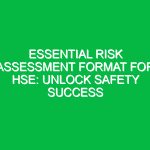Introduction
In the realm of Health, Safety, and Environment (HSE), risk analysis serves as a critical component for ensuring a safe workplace and protecting environmental integrity. A risk analysis example provides a practical illustration of how organizations can identify, evaluate, and mitigate risks associated with their operations. The relevance of this process cannot be understated; it is essential for preventing accidents, ensuring compliance with Regulations, and fostering a culture of Safety. By exploring a detailed risk analysis example, we can better understand its components, methodologies, and the vital role it plays in safeguarding both people and the environment.
Key Aspects of Risk Analysis in HSE
Risk analysis within the HSE framework encompasses several key aspects that ensure a thorough evaluation of potential Hazards. Understanding these components is crucial for implementing effective risk management strategies.
1. Identification of Hazards
The first step in any risk analysis example is the identification of hazards. This involves a systematic process of recognizing all potential sources of harm in the workplace. Hazards can be categorized as physical (e.g., machinery, chemicals), biological (e.g., bacteria, viruses), ergonomic (e.g., repetitive motion injuries), and psychosocial (e.g., workplace stress). For instance, in a manufacturing facility, one might identify machine Operation as a physical hazard, while workplace stress due to long shifts could be categorized under psychosocial hazards.
2. Risk Assessment
Once hazards are identified, the next step is to assess the risks associated with them. This involves evaluating the likelihood of each hazard causing harm and the potential severity of that harm. Risk assessment can be qualitative, using descriptive terms to classify risk levels, or quantitative, employing numerical values to quantify risk. For example, a risk assessment might reveal that the likelihood of injury from operating a specific piece of machinery is high, and the potential severity of that injury is critical, leading to a high overall risk rating.
3. Risk Control Measures
After assessing risks, organizations must implement Control Measures to mitigate them. Control measures can be categorized into several types:
- Elimination: Removing the hazard entirely.
- Substitution: Replacing the hazard with a less dangerous option.
- Engineering Controls: Implementing physical changes to the workplace, such as installing guards on machines.
- Administrative Controls: Changing work practices or Procedures to reduce exposure.
- PPE (Personal Protective Equipment): Providing protective gear for workers.
Implementing these controls effectively can significantly reduce the risks associated with identified hazards. For instance, if a chemical spill represents a risk, the organization may choose to implement engineering controls, such as improved ventilation systems, alongside administrative controls, like regular Training for employees on safe handling procedures.
4. Monitoring and Review
Risk analysis is not a one-time event; it requires ongoing monitoring and review. Regularly revisiting the risk analysis example helps ensure that control measures remain effective and relevant, especially when operational changes occur or new hazards emerge. For example, if a new piece of equipment is introduced in a manufacturing plant, a review of the existing risk analysis may reveal the need for updated training or additional Safety Measures.
Benefits of Conducting a Risk Analysis
Conducting a risk analysis offers numerous Benefits that extend beyond mere compliance with regulations. Here are some key advantages:
- Enhanced Safety: A well-implemented risk analysis leads to safer working environments, reducing the likelihood of accidents and injuries.
- Informed Decision-Making: Risk analysis provides data-driven insights that help management make informed decisions regarding resource allocation and safety investments.
- Regulatory Compliance: Adhering to legal requirements becomes easier when a robust risk analysis framework is in place.
- Improved Reputation: Organizations committed to safety and environmental stewardship enhance their reputation among employees, stakeholders, and the public.
Best Practices for Risk Analysis in HSE
To maximize the effectiveness of risk analysis, organizations should adhere to several Best Practices:
1. Involve Employees
Involving employees in the risk analysis process can provide valuable insights into potential hazards that management may overlook. Workers often have firsthand knowledge of risks associated with their tasks, making their input crucial.
2. Use a Systematic Approach
Utilizing a structured methodology, such as the Hazard and Operability Study (HAZOP) or Failure Mode and Effects Analysis (FMEA), can enhance the comprehensiveness of the risk analysis. These methods guide teams through a systematic evaluation of processes and potential failure points.
3. Document Everything
Thorough documentation of the risk analysis process, findings, and actions taken is essential. This not only facilitates compliance with regulations but also serves as a reference for future risk assessments and training purposes.
4. Provide Training
Regular training on risk analysis procedures and Safety Measures ensures that all employees understand the importance of the process and their role in maintaining a safe workplace.
Real-Life Example: Risk Analysis in Action
To illustrate the importance of risk analysis, consider the case of a construction company that undertook a comprehensive risk analysis of its operations. The analysis revealed several key hazards, including falls from heights, equipment-related injuries, and exposure to hazardous materials.
The company implemented several control measures:
- They conducted training sessions on Fall Prevention and the proper use of Personal Protective Equipment.
- They installed guardrails and safety nets on construction sites to prevent falls.
- They provided Material Safety Data Sheets (MSDS) to all employees working with hazardous materials to ensure proper handling and emergency procedures were clear.
As a result of these measures, the company saw a significant reduction in workplace accidents and injuries over the following year. This case highlights how a proactive approach to risk analysis not only enhances safety but also positively impacts the organization’s bottom line.
Regulations and Standards Impacting Risk Analysis
Risk analysis in the HSE context is governed by various regulations and standards that ensure organizations maintain safety and environmental integrity. Key regulations include:
- Occupational Safety and Health Administration (OSHA) Standards: These regulations set forth requirements for Workplace Safety and health, necessitating risk assessments to identify and mitigate hazards.
- Environmental Protection Agency (EPA) Regulations: These regulations require organizations to assess environmental risks and implement measures to protect natural resources.
- ISO 45001: This international standard outlines requirements for Occupational Health and safety management systems, emphasizing the need for risk identification and management.
Understanding and complying with these regulations not only protects workers but also safeguards the environment, demonstrating an organization’s commitment to responsible operations.
Conclusion
In summary, a comprehensive risk analysis example serves as a cornerstone for fostering health, safety, and environmental Sustainability in the workplace. By systematically identifying hazards, assessing risks, and implementing control measures, organizations can create safer environments for their employees and minimize their ecological footprint. The benefits of conducting risk analysis extend beyond compliance, enhancing overall organizational performance and reputation. As we continue to navigate the complexities of the modern workplace, embracing risk analysis as a fundamental practice will be paramount in safeguarding our most valuable assets: our people and our planet. It is crucial for organizations to prioritize this process and continually seek improvements, ensuring that safety is not just a priority but a foundational aspect of their culture.


